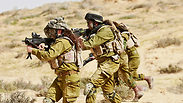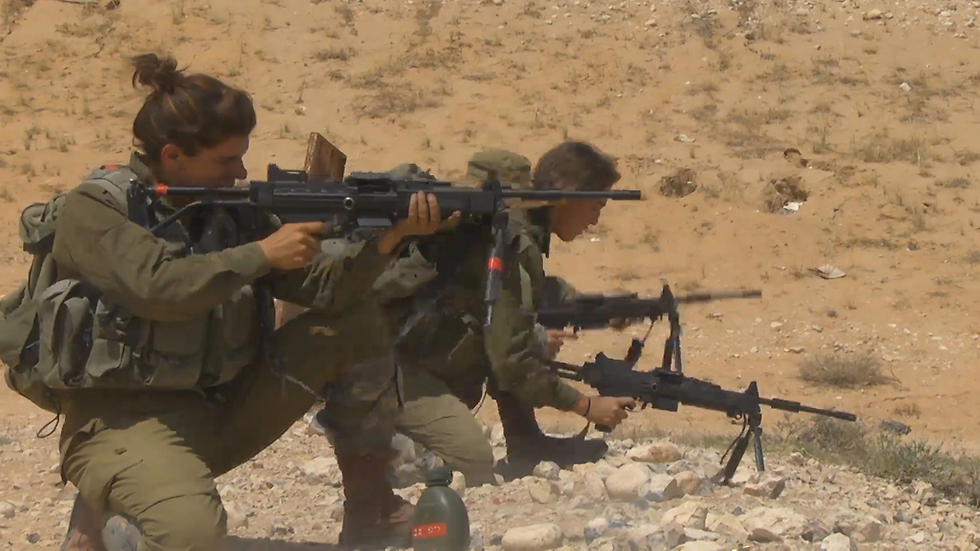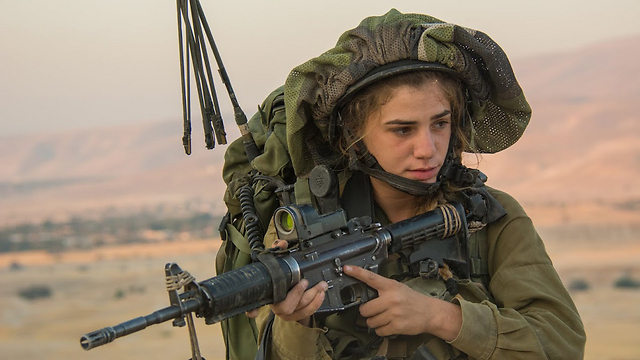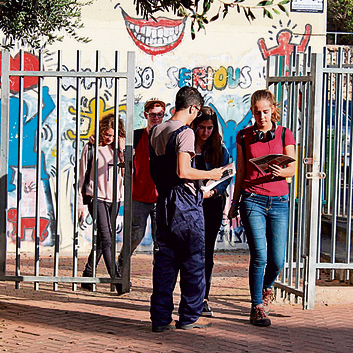

Number of women in combat roles reaches record high
IDF's four mixed gender battalion add 2,700 female soldiers in 2017—compared to 547 in 2012—a record high that continues a 5-year trend of women seeking combat postings; organizations such as Brothers in Arms attempt to battle female accession to combat roles by handing out pamphlets in schools warning away from supposed dangers of service.
Recruitment of young women to IDF combat roles as part of the November 2017 draft was underway Tuesday, and saw an impressive increase in the number of women seeking combat postings.
No less than 2,700 women were recruited during 2017 to mixed-gender battalions—Caracal, Bardelas (or Cheetah), the Lions of Jordan and Lavi HaBik'a—and to Home Front Command's Rescue and Instruction Division.
2017's number marks a record high, continuing a trend that started five years ago.
In 2012, 600 young women joined coed battalions. The following year their numbers grew to 1,365 and have been on a steady increase since, right up to 2016 when 2,100 women sought combat roles. Compared to last year, then, there has been a 30 percent increase in the number of women in the IDF's combat battalions.
The IDF said one of the reasons behind the ever-growing numbers of young women interested in combat postings is a series of special relief measures and adjustments made recently. Combat Intelligence Collection Corps Commander Brig.-Gen. Mordechai Kahane, whose corps is in charge of all four coed battalions, decided to lower the basic training bar and do away with an obstacle course test as well as a requirement to scale a wall, a component in the assessment process that has proven to be, in many cases, an insurmountable obstacle for women.
The process for reducing the pressure exerted on female soldiers during their basic training began in August as part of a program headed by Kahane, intended to discern and learn key lessons from basic training methods in recent years.
The new form of basic training has been underway in a new southern-region base created especially for the coed battalions in Sayarim.
The IDF has in the past been criticized for the fact that girls were required to either clear a smaller wall or were assisted by a bench. Unlike the US army, which sets an identical bar for men and women in their military training, the IDF permits different criteria for women in accordance with physiological differences.
Kahane, who served in the past as a commander of the special "Egoz" unit during the Second Lebanon War and fought in Gaza, argued that there was no justification for demanding that women surmount a wall as they undergo their basic training.
"In two wars in Lebanon and Gaza I never saw a need to clear this kind of wall," Kahane said during discussions on the matter.
Six months ago he instructed that the number of full magazines carried by women in their combat vests be reduced from six to four.
"If four magazines are not enough for female soldiers, while other male and female soldiers are around them, the battle has already been decided," Kahane told commanders at the time.
"When I was a commander in Egoz we fought in Lebanon for more than 30 days and there was not a single soldier for whom the magazines in his vest were not enough," he added.
Commander of Home Front Command's Rescue and Instruction Division Col. Yair Barkat said during his visit this week to the army's induction center that the young women's motivation to serve was exceedingly high, as was their quality. The drop-out rate among female recruits was no higher than that of their male counterparts, Barkat said, and added claims they either drop out or are injured in greater numbers were utterly baseless. "It's an urban legend," Col. Barkat assured.
In response to the increase in the number of girls seeking combat posts over the past few years, several organizations such as Brothers in Arms have decided to escalate their struggle against women being enlisted to combat roles.
Brothers in Arms activists stood at the entrance to schools nationwide Wednesday to trumpet their agenda under the heading "Recruit of female combat soldiers—grievous injury to the State of Israel's security fortitude."
As part of their operation, activists will be handing out tens of thousands of copies of a pamphlet produced by Brothers in Arms especially for young women of conscription age. The pamphlet includes information about the supposed dangers of female accession to combat duties, weakening of national strength and the army's ability to carry out its duties and grave health problems women in such roles are afflicted with during their service.
The Brothers in Arms pamphlet argued, for instance, that 46 percent of all female combat soldiers will be injured, compared to 24 percent of their male counterparts, that 69 percent of women dropping out of the mixed gender battalions do so for medical reasons and other worrying bits of information.
Countering the organization's claims, the IDF posited its data is out of date and only true as of 2012. "This is a cynical use of old data to cripple female enlistment," IDF officials said.
Senior army officials further added that due to the coed battalions' labor pains, a special program was put together to integrate the women, including close accompaniment by doctors, setting a special bar to measure their efforts, building unique infrastructures and erecting a special training base.
The IDF further noted the rate of injuries among women in combat roles was merely 26 percent, equal to that of men, and that the rest of the data in the pamphlet was not accurate.




















